Dynamic Simulation of the Crown Net Photosynthetic Rate for Young Larix olgensis Henry Trees
Abstract
1. Introduction
2. Materials and Methods
2.1. Site Description and Sample Tree Selection
2.2. Measurements of the PLR Curves
2.3. Measurements of the RDINC and LMA
2.4. Measurements of PAR within the Crown
2.5. Calculation of the Leaf Area and LAI
2.6. Meteorological Data Collection
2.7. Statistical Analysis
2.7.1. Model Descriptions
2.7.2. Model Assessment and Validation
3. Results
3.1. Correlations between Photosynthetic Parameters and the RDINC, Tleaf, VPD and LMA
3.2. Simulation of the Responses of the An to PAR under Different Conditions
3.3. Vertical Patterns of PAR and k within the Crown
3.4. Estimation of k
3.5. Dynamic Simulation of the An within the Crown throughout the Whole Growing Season
4. Discussion
5. Conclusions
Author Contributions
Funding
Acknowledgments
Conflicts of Interest
References
- Zhang, X.Q.; Xu, D.Y. Eco-physiological modelling of canopy photosynthesis and growth of a Chinese fir plantation. For. Ecol. Manag. 2003, 173, 201–211. [Google Scholar] [CrossRef]
- Wang, P.; Sun, R.; Hu, J.; Zhu, Q.; Zhou, Y.Y.; Li, L.; Chen, J.M. Measurements and simulation of forest leaf area index and net primary productivity in Northern China. J. Environ. Manag. 2007, 85, 607–615. [Google Scholar] [CrossRef] [PubMed]
- Sato, H.; Itoh, A.; Kohyama, T. SEIB-DGVM: A new dynamic global vegetation model using a spatially explicit individual-based approach. Ecol. Model. 2007, 200, 279–307. [Google Scholar] [CrossRef]
- Allen, A.P.; Gillooly, J.F.; Brown, J.H. Linking the global carbon cycle to individual metabolism. Funct. Ecol. 2005, 19, 202–213. [Google Scholar] [CrossRef]
- Quan, X.K.; Wang, C.K. Acclimation and adaptation of leaf photosynthesis, respiration and phenology to climate change: A 30-year Larix gmelinii common-garden experiment. For. Ecol. Manag. 2018, 411, 166–175. [Google Scholar]
- Wright, I.J.; Reich, P.B.; Westoby, M.; Ackerly, D.D.; Baruch, Z.; Bongers, F.; Cavender-Bares, J.; Chapin, T.; Cornelissen, J.H.C.; Diemer, M.; et al. The worldwide leaf economics spectrum. Nature 2004, 428, 821–827. [Google Scholar] [CrossRef] [PubMed]
- Liu, Q.; Dong, L.H.; Li, F.R. Modeling net CO2, assimilation (AN) within the crown of young planted Larix olgensis trees. Can. J. For. Res. 2018, 48, 1085–1098. [Google Scholar] [CrossRef]
- Kerr, G.; Morgan, G. Does formative pruning improve the form of broadleaved trees? Can. J. For. Res. 2006, 36, 132–141. [Google Scholar] [CrossRef]
- Springmanna, S.; Rogersb, R.; Spiecker, H. Impact of artificial pruning on growth and secondary shoot development of wild cherry (Prunus avium L.). For. Ecol. Manag. 2011, 261, 764–769. [Google Scholar] [CrossRef]
- Reich, P.B.; Ellsworth, D.S.; Kloeppel, B.D.; Fownes, J.H.; Gower, S. Vertical variation in canopy structure and CO2 exchange of oak-maple forests: Influence of ozone, nitrogen, and other factors on simulated canopy carbon gain. Tree Physiol. 1990, 7, 329–345. [Google Scholar] [CrossRef]
- Marino, G.; Aqil, M.; Shipley, B. The leaf economics spectrum and the prediction of photosynthetic light-response curves. Funct. Ecol. 2010, 24, 263–272. [Google Scholar] [CrossRef]
- Atkinson, L.J.; Campbell, C.D.; Zaragoza-Castells, J.; Hurry, V.; Atkin, O.K. Impact of growth temperature on scaling relationships linking photosynthetic metabolism to leaf functional traits. Funct. Ecol. 2010, 24, 1181–1191. [Google Scholar] [CrossRef]
- Cavaleri, M.A.; Oberbauer, S.F.; Clark, D.B.; Clark, D.A.; Ryan, M.G. Height is more important than light in determining leaf morphology in a tropical forest. Ecology 2010, 91, 1730–1739. [Google Scholar] [CrossRef]
- Falster, D.S.; Brännström, Å.; Dieckmann, U.; Westoby, M. Influence of four major plant traits on average height, leaf-area cover, net primary productivity, and biomass density in single-species forests: A theoretical investigation. J. Ecol. 2011, 99, 148–164. [Google Scholar] [CrossRef]
- Chiarawipa, R.; Rueangkhanab, M.; Wang, Y.; Zhang, X.Z.; Han, Z.H. Modeling light acclimation of photosynthetic response in different ages of vine leaves. Acta Hortic. 2012, 956, 255–260. [Google Scholar] [CrossRef]
- Lachapelle, P.P.; Shipley, B. Interspecific prediction of photosynthetic light response curves using specific leaf mass and leaf nitrogen content: Effects of differences in soil fertility and growth irradiance. Ann. Bot. 2012, 109, 1149–1157. [Google Scholar] [CrossRef]
- Liu, Q.; Li, F.R. Spatial and Seasonal Variations of Standardized Photosynthetic Parameters under Different Environmental Conditions for Young Planted Larix olgensis Henry Trees. Forests 2018, 9, 522. [Google Scholar] [CrossRef]
- Rook, D.A.; Corson, M.J. Temperature and irradiance and the total daily photosynthetic production of the crown of a Pinus radiate tree. Oecologia 1978, 36, 371–382. [Google Scholar] [CrossRef]
- Mengistu, T.; Sterck, F.J.; Fetene, M.; Tadesse, W.; Bongers, F. Leaf gas exchange in the frankincense tree (Boswellia papyrifera) of African dry woodlands. Tree Physiol. 2001, 31, 740–750. [Google Scholar] [CrossRef]
- Calama, R.; Puértolas, J.; Madrigal, G.; Pardos, M. Modeling the environmental response of leaf net photosynthesis in Pinus pinea L. natural regeneration. Ecol. Model. 2013, 251, 9–21. [Google Scholar] [CrossRef]
- Bond, B.J. Age-related changes in photosynthesis of woody plants. Trends Plant Sci. 2000, 5, 349–353. [Google Scholar] [CrossRef]
- Wyka, T.P.; Żytkowiak, R.; Oleksyn, J. Seasonal dynamics of nitrogen level and gas exchange in different cohorts of Scots pine needles: A conflict between nitrogen mobilization and photosynthesis? Eur. J. For. Res. 2016, 135, 483–493. [Google Scholar] [CrossRef]
- Kull, O. Acclimation of photosynthesis in canopies: Models and limitations. Oecologia 2002, 133, 267–279. [Google Scholar] [CrossRef]
- Amthor, J.S. Scaling CO2–photosynthesis relationships from the leaf to the canopy. Photosynth. Res. 1994, 39, 321–350. [Google Scholar] [CrossRef]
- Leuning, R.; Kelliher, F.M.; Pury, D.G.G.; Schulze, E.D. Leaf nitrogen, photosynthesis, conductance and transpiration: Scaling from leaves to canopies. Plant Cell Environ. 1995, 18, 1183–1200. [Google Scholar] [CrossRef]
- Wang, Y.P.; Leuning, R. A two-leaf model for canopy conductance, photosynthesis and partitioning of available energy. I: Model description and comparison with a multi-layered model. Agric. For. Meteorol. 1998, 91, 89–111. [Google Scholar] [CrossRef]
- Farquhar, G.D.; von Caemmerer, S.; Berry, J.A. A biochemical model of photosynthetic CO2 assimilation in leaves of C3 species. Planta 1980, 149, 78–90. [Google Scholar] [CrossRef]
- Jin, S.; Zhou, X.; Fan, J. Modeling daily photosynthesis of nine major tree species in northeast China. For. Ecol. Manag. 2003, 184, 125–140. [Google Scholar] [CrossRef]
- Mayoral, C.; Calama, R.; Sánchez-González, M.; Pardos, M. Modelling the influence of light, water and temperature on photosynthesis in young trees of mixed Mediterranean forests. New For. 2015, 46, 485–506. [Google Scholar] [CrossRef]
- Lambers, H.; Chapin, F.S.; Pons, T.L. Plant Physiological Ecology; Springer: New York, NY, USA, 1998. [Google Scholar]
- Rijkers, T.; Pons, T.L.; Bongers, F. The Effect of Tree Height and Light Availability on Photosynthetic Leaf Traits of Four Neotropical Species Differing in Shade Tolerance. Funct. Ecol. 2000, 14, 77–86. [Google Scholar] [CrossRef]
- Xu, J.Z.; Yu, Y.M.; Peng, S.Z.; Yang, S.H.; Liao, L.X. A modified nonrectangular hyperbola equation for photosynthetic light-response curves of leaves with different nitrogen status. Photosynthetica 2014, 52, 117–123. [Google Scholar] [CrossRef]
- Riikonen, J.; Oksanen, E.; Peltonen, P.; Holopainen, T.; Vapaavuori, E. Seasonal variation in physiological characteristics of two silver birch clones in the field. Can. J. For. Res. 2003, 33, 2164–2176. [Google Scholar] [CrossRef]
- Han, Q.M. Height-related decreases in mesophyll conductance, leaf photosynthesis and compensating adjustments associated with leaf nitrogen concentrations in Pinus densiflora. Tree Physiol. 2011, 31, 976–984. [Google Scholar] [CrossRef]
- Mullin, L.P.; Sillett, S.C.; Koch, G.; Tu, K.; Antoine, M.E. Physiological consequences of height-related morphological variation in Sequoia sempervirens foliage. Tree Physiol. 2009, 29, 1–12. [Google Scholar] [CrossRef]
- Flexas, J.; Barbour, M.M.; Brendel, O.; Cabrera, H.M.; Carriquí, M.; Díaz-Espejo, A.; Douthe, C.; Dreyer, E.; Ferrio, J.P.; Gago, J.; et al. Mesophyll diffusion conductance to CO2: An unappreciated central player in photosynthesis. Plant Sci. 2012, 193, 70–84. [Google Scholar] [CrossRef]
- Woodruff, D.R. The impacts of water stress on phloem transport in Douglas-fir trees. Tree Physiol. 2014, 34, 5–14. [Google Scholar] [CrossRef]
- Bond, B.J.; Farnsworth, B.T.; Coulombe, R.A.; Winner, W.E. Foliage physiology and biochemistry in response to light gradients in conifers with varying shade tolerance. Oecologia 1999, 120, 183–192. [Google Scholar] [CrossRef]
- Shipley, B.; Vile, D.; Garnier, E.; Wright, I.J.; Poorter, H. Functional Linkages between Leaf Traits and Net Photosynthetic Rate: Reconciling Empirical and Mechanistic Models. Funct. Ecol. 2005, 19, 602–615. [Google Scholar] [CrossRef]
- Givnish, T.J.; Montgomery, R.A.; Goldstein, G. Adaptive radiation of photosynthetic physiology in the Hawaiian lobeliads: Light regimes, static light responses, and whole-plant compensation points. Am. J. Bot. 2004, 91, 228–246. [Google Scholar] [CrossRef]
- Arora, A.; Singh, V.P.; Mohan, J. Effect of nitrogen and water stress on photosynthesis and nitrogen content in wheat. Biol. Plant. 2001, 44, 153–155. [Google Scholar] [CrossRef]
- Kull, O.; Kruijt, B. Leaf photosynthetic light response: A mechanistic model for scaling photosynthesis to leaves and canopies. Funct. Ecol. 1998, 12, 767–777. [Google Scholar] [CrossRef]
- Atkin, O.K.; Scheurwater, I.; Pons, T.L. High thermal acclimation potential of both photosynthesis and respiration in two lowland Plantago species in contrast to an alpine congeneric. Glob. Chang. Biol. 2006, 12, 500–515. [Google Scholar] [CrossRef]
- Sage, R.F.; Kubien, D.S. The temperature response of C3, and C4, photosynthesis. Plant Cell Environ. 2010, 30, 1086–1106. [Google Scholar] [CrossRef]
- Campbell, C.; Atkinson, L.; Zaragoza-Castells, J.; Lundmark, M.; Atkin, O.; Hurry, V. Acclimation of photosynthesis and respiration is asynchronous in response to changes in temperature regardless of plant functional group. New Phytol. 2007, 176, 375–389. [Google Scholar] [CrossRef]
- Kosugi, Y.; Shibata, S.; Kobashi, S. Parameterization of the CO2 and H2O gas exchange of several temperate deciduous broad-leaved trees at the leaf scale considering seasonal changes. Plant Cell Environ. 2003, 26, 285–301. [Google Scholar] [CrossRef]
- Han, Q.; Kawasaki, T.; Katahata, S.; Mukai, Y.; Chiba, Y. Horizontal and vertical variations in photosynthetic capacity in a Pinus densiflora crown in relation to leaf nitrogen allocation and acclimation to irradiance. Tree Physiol. 2003, 23, 851–857. [Google Scholar] [CrossRef]
- O’Grady, A.P.; Worledge, D.; Wilkinson, A.; Battaglia, M. Photosynthesis and respiration decline with light intensity in dominant and suppressed Eucalyptus globulus canopies. Funct. Plant Biol. 2008, 35, 439–447. [Google Scholar] [CrossRef]
- Weerasinghe, L.K.; Creek, D.; Crous, K.Y.; Xiang, S.; Liddell, M.J.; Turnbull, M.H.; Atkin, O.K. Canopy position affects the relationships between leaf respiration and associated traits in a tropical rainforest in Far North Queensland. Tree Physiol. 2014, 34, 564–584. [Google Scholar] [CrossRef]
- Hamada, S.; Kumagai, T.; Kochi, K.; Kobayashi, N.; Hiyama, T.; Miyazawa, Y. Spatial and temporal variations in photosynthetic capacity of a temperate deciduous-evergreen forest. Trees 2016, 30, 1083–1093. [Google Scholar] [CrossRef]
- Prentice, I.C.; Leemans, R. Pattern and Process and the Dynamics of Forest Structure: A Simulation Approach. J. Ecol. 1990, 78, 340–355. [Google Scholar] [CrossRef]
- Kohler, P.; Huth, A. The effects of tree species grouping in tropical rainforest modelling: Simulations with the individual-based model Formind. Ecol. Model. 1998, 109, 301–321. [Google Scholar] [CrossRef]
- Sitch, S.; Smith, B.; Prentice, I.C. Evaluation of ecosystem dynamics, plant geography and terrestrial carbon cycling in the LPJ dynamic global vegetation model. Glob. Chang. Biol. 2003, 9, 161–185. [Google Scholar] [CrossRef]
- Yan, X.; Shugart, H. FAREAST: A forest gap model to simulate dynamics and patterns of eastern Eurasian forests. J. Biogeogr. 2010, 32, 1641–1658. [Google Scholar]
- Clark, D.B.; Mercado, L.M.; Sitch, S.; Jones, C.D.; Gedney, N.; Best, M.J.; Pryor, M.; Rooney, G.G.; Essery, R.L.H.; Blyth, E.; et al. The Joint UK Land Environment Simulator (JULES), model description—Part 2: Carbon fluxes and vegetation dynamics. Geosci. Model Dev. 2011, 4, 701–722. [Google Scholar] [CrossRef]
- Vose, J.M.; Swank, W.T. Assessing seasonal leaf area dynamics and vertical leaf area distribution in eastern white pine (Pinus strobus L.) with a portable light meter. Tree Physiol. 1990, 7, 125–134. [Google Scholar] [CrossRef]
- Vose, J.M.; Clinton, B.D.; Sullivan, N.H.; Bolstad, P.V. Vertical leaf area distribution, light transmittance, and application of the Beer–Lambert Law in four mature hardwood stands in the southern Appalachians. Can. J. For. Res. 1995, 25, 1036–1043. [Google Scholar] [CrossRef]
- Monsi, M. On the factor light in plant communities and its importance for matter production. Ann. Bot. 2005, 95, 549–567. [Google Scholar] [CrossRef]
- Campbell, G.S. Extinction coefficients for radiation in plant canopies calculated using an ellipsoidal inclination angle distribution. Agric. For. Meteorol. 1986, 36, 317–321. [Google Scholar] [CrossRef]
- Campbell, G.S. Derivation of an angle density function for canopies with ellipsoidal leaf angle distributions. Agric. For. Meteorol. 1990, 49, 173–176. [Google Scholar] [CrossRef]
- Wang, Y.P.; Jarvis, P.G. Influence of crown structural properties on PAR absorption, photosynthesis, and transpiration in Sitka spruce: Application of a model (MAESTRO). Tree Physiol. 1990, 7, 297–316. [Google Scholar] [CrossRef]
- Chen, J.M.; Leblanc, S.G. A four-scale bidirectional reflectance model based on canopy architecture. IEEE Trans. Geosci. Remote Sens. 1997, 35, 1316–1337. [Google Scholar] [CrossRef]
- Wang, W.M.; Li, Z.L.; Su, H.B. Comparison of leaf angle distribution functions: Effects on extinction coefficient and fraction of sunlit foliage. Agric. For. Meteorol. 2007, 143, 106–122. [Google Scholar] [CrossRef]
- Wirth, R.; Weber, B.; Ryel, R.J. Spatial and temporal variability of canopy structure in a tropical moist forest. Acta Oecol. 2001, 22, 235–244. [Google Scholar] [CrossRef]
- Aubin, I.; Beaudet, M.; Messier, C. Light extinction coefficients specific to the understory vegetation of the southern boreal forest, Quebec. Can. J. For. Res. 2000, 30, 168–177. [Google Scholar] [CrossRef]
- Pierce, L.L.; Running, S.W. Rapid Estimation of Coniferous Forest Leaf Area Index Using a Portable Integrating Radiometer. Ecology 1988, 69, 1762–1767. [Google Scholar] [CrossRef]
- Liu, Q.; Dong, L.H.; Li, F.R.; Xie, L.F. Spatial heterogeneity of canopy photosynthesis for Larix olgensis. Chin. J. Appl. Ecol. 2016, 27, 2789–2796. (In Chinese) [Google Scholar]
- Cluzeau, C.; Goff, N.L.; Ottorini, J.M. Development of primary branches and crown profile of Fraxinus excelsior. Can. J. For. Res. 1994, 24, 2315–2323. [Google Scholar] [CrossRef]
- Bassman, J.H.; Zwier, J.C. Gas exchange characteristics of Populus trichocarpa, Populus deltoides and Populus trichocarpa × P. deltoides clones. Tree Physiol. 1991, 8, 145–159. [Google Scholar] [CrossRef]
- Niinemets, U.; Kull, O.; Tenhunen, J.D. Within-canopy variation in the rate of development of photosynthetic capacity is proportional to integrated quantum flux density in temperate deciduous trees. Plant Cell Environ. 2004, 27, 293–313. [Google Scholar] [CrossRef]
- Griffin, K.L.; Tissue, D.T.; Turnbull, M.H.; Schuster, W.; Whitehead, D. Leaf dark respiration as a function of canopy position in Nothofagus fusca trees grown at ambient and elevated CO2 partial pressures for 5 years. Funct. Ecol. 2001, 15, 497–505. [Google Scholar] [CrossRef]
- Xu, C.Y.; Griffin, K.L. Seasonal variation in the temperature response of leaf respiration in Quercus rubra: Foliage respiration and leaf properties. Funct. Ecol. 2006, 20, 778–789. [Google Scholar] [CrossRef]
- Ambrose, A.R.; Sillett, S.C.; Dawson, T.E. Effects of tree height on branch hydraulics, leaf structure and gas exchange in California redwoods. Plant Cell Environ. 2009, 32, 743–757. [Google Scholar] [CrossRef]
- Kosugi, Y.; Takanashi, S.; Yokoyama, N.; Kamakura, M. Vertical variation in leaf gas exchange parameters for a Southeast Asian tropical rainforest in Peninsular Malaysia. J. Plant Res. 2012, 125, 735–748. [Google Scholar] [CrossRef]
- Fellner, H.; Dirnberger, G.F.; Sterba, H. Specific leaf area of European Larch (Larix decidua Mill.). Trees 2016, 30, 1237–1244. [Google Scholar] [CrossRef]
- Kenzo, T.; Ichie, T.; Watanabe, Y.; Koike, T. Changes in photosynthesis and leaf characteristics with tree height in five dipterocarp species in a tropical rain forest. Tree Physiol. 2006, 26, 865–873. [Google Scholar] [CrossRef]
- Meinzer, F.C.; Bond, B.J.; Karanian, J.A. Biophysical constraints on leaf expansion in a tall conifer. Tree Physiol. 2008, 28, 197–206. [Google Scholar] [CrossRef]
- Sperlich, D.; Chang, C.T.; Penuelas, J.; Gracia, C.; Sabaté, S. Seasonal variability of foliar photosynthetic and morphological traits and drought impacts in a Mediterranean mixed forest. Tree Physiol. 2015, 35, 501–520. [Google Scholar] [CrossRef]
- Marshall, J.D.; Monserud, R.A. Foliage height influences specific leaf area of three conifer species. Can. J. For. Res. 2003, 33, 164–170. [Google Scholar] [CrossRef]
- Koch, G.W.; Sillett, S.C.; Jennings, G.M.; Davis, S.D. The limits to tree height. Nature 2004, 428, 851–854. [Google Scholar] [CrossRef]
- Xiao, C.W.; Janssens, I.A.; Yuste, J.C.; Ceulemans, R. Variation of specific leaf area and upscaling to leaf area index in mature scots pine. Trees 2006, 20, 304–310. [Google Scholar] [CrossRef]
- Hikosaka, K.; Nabeshima, E.; Hiura, T. Seasonal changes in the temperature response of photosynthesis in canopy leaves of Quercus crispula in a cool-temperate forest. Tree Physiol. 2007, 27, 1035–1041. [Google Scholar] [CrossRef]
- Way, D.A.; Sage, R.F. Thermal acclimation of photosynthesis in black spruce [Picea mariana (Mill). B.S.P.]. Plant Cell Environ. 2008, 31, 1250–1262. [Google Scholar] [CrossRef]
- Wieser, G.; Oberhuber, W.; Walder, L.; Spieler, D.; Gruber, A. Photosynthetic temperature adaptation of Pinus cembra, within the timberline ecotone of the Central Austrian Alps. Ann. For. Sci. 2010, 67, 201. [Google Scholar] [CrossRef]
- Lin, Y.S.; Medlyn, B.E.; Ellsworth, D.S. Temperature responses of leaf net photosynthesis: The role of component processes. Tree Physiol. 2012, 32, 219–231. [Google Scholar] [CrossRef]
- Rodríguez-calcerrada, J.; Atkin, O.K.; Robson, T.M.; Zaragoza-castells, J.; Gil, L.; Aranda, I. Thermal acclimation of leaf dark respiration of beech seedlings experiencing summer drought in high and low light environments. Tree Physiol. 2010, 30, 214–224. [Google Scholar] [CrossRef]
- Day, M.E. Influence of temperature and leaf-to-air vapor pressure deficit on net photosynthesis and stomatal conductance in red spruce (Picea rubens). Tree Physiol. 2000, 20, 57–63. [Google Scholar] [CrossRef]
- Awada, T.; Radoglou, K.; Fotelli, M.N.; Constantinidou, H.I.A. Ecophysiology of seedlings of three Mediterranean pine species in contrasting light regimes. Tree Physiol. 2003, 23, 33–41. [Google Scholar] [CrossRef]
- Voelker, S.L.; Meinzer, F.C.; Way, D. Where and when does stem cellulose δ18O reflect a leaf water enrichment signal? Tree Physiol. 2017, 37, 551–553. [Google Scholar] [CrossRef][Green Version]
- Cannell, M.G.R.; Thornley, J.H.M. Temperature and CO2 Responses of Leaf and Canopy Photosynthesis: A Clarification using the Non-rectangular Hyperbola Model of Photosynthesis. Ann. Bot. 1998, 82, 883–892. [Google Scholar] [CrossRef]
- Xu, J.Z.; Wang, Y.H.; Yang, S.H.; Peng, S.Z.; Kong, W.L. Improved performance of photosynthetic light response equations with unified parameters for rice leaves with different SPAD values. Pak. J. Bot. 2015, 47, 877–882. [Google Scholar]
- Wilson, K.B.; Baldocchi, D.D.; Hanson, P.J. Leaf age affects the seasonal pattern of photosynthetic capacity and net ecosystem exchange of carbon in a deciduous forest. Plant Cell Environ. 2001, 24, 571–583. [Google Scholar] [CrossRef]
- Tanaka, K.; Kosugi, Y.; Nakamura, A. Impact of leaf physiological characteristics on seasonal variation in CO2, latent and sensible heat exchanges over a tree plantation. Agric. For. Meteorol. 2002, 114, 103–122. [Google Scholar] [CrossRef]
- Grassi, G.; Vicinelli, E.; Ponti, F.; Cantoni, L.; Magnani, F. Seasonal and interannual variability of photosynthetic capacity in relation to leaf nitrogen in a deciduous forest plantation in northern Italy. Tree Physiol. 2005, 25, 349–360. [Google Scholar] [CrossRef] [PubMed]
- Coble, A.P.; Vanderwall, B.; Mau, A.; Cavaleri, M. How vertical patterns in leaf traits shift seasonally and the implications for modeling canopy photosynthesis in a temperate deciduous forest. Tree Physiol. 2016, 36, 1077–1091. [Google Scholar] [CrossRef]
- Nouvellon, Y.; Laclau, J.P.; Epron, D.; Kinana, A.; Mabiala, A.; Roupsard, O.; Bonnefond, J.M.; Maire, G.; Marsden, C.; Bontemps, J.D.; et al. Within-stand and seasonal variations of specific leaf area in a clonal Eucalyptus plantation in the Republic of Congo. For. Ecol. Manag. 2010, 259, 1796–1807. [Google Scholar] [CrossRef]
- Bauerle, W.L.; Oren, R.; Way, D.A.; Qian, S.S.; Stoy, P.C.; Thornton, P.E.; Bowden, J.D.; Hoffman, F.M.; Reynolds, R.F. Photoperiodic regulation of the seasonal pattern of photosynthetic capacity and the implications for carbon cycling. Proc. Natl. Acad. Sci. USA 2012, 109, 8612–8617. [Google Scholar] [CrossRef]
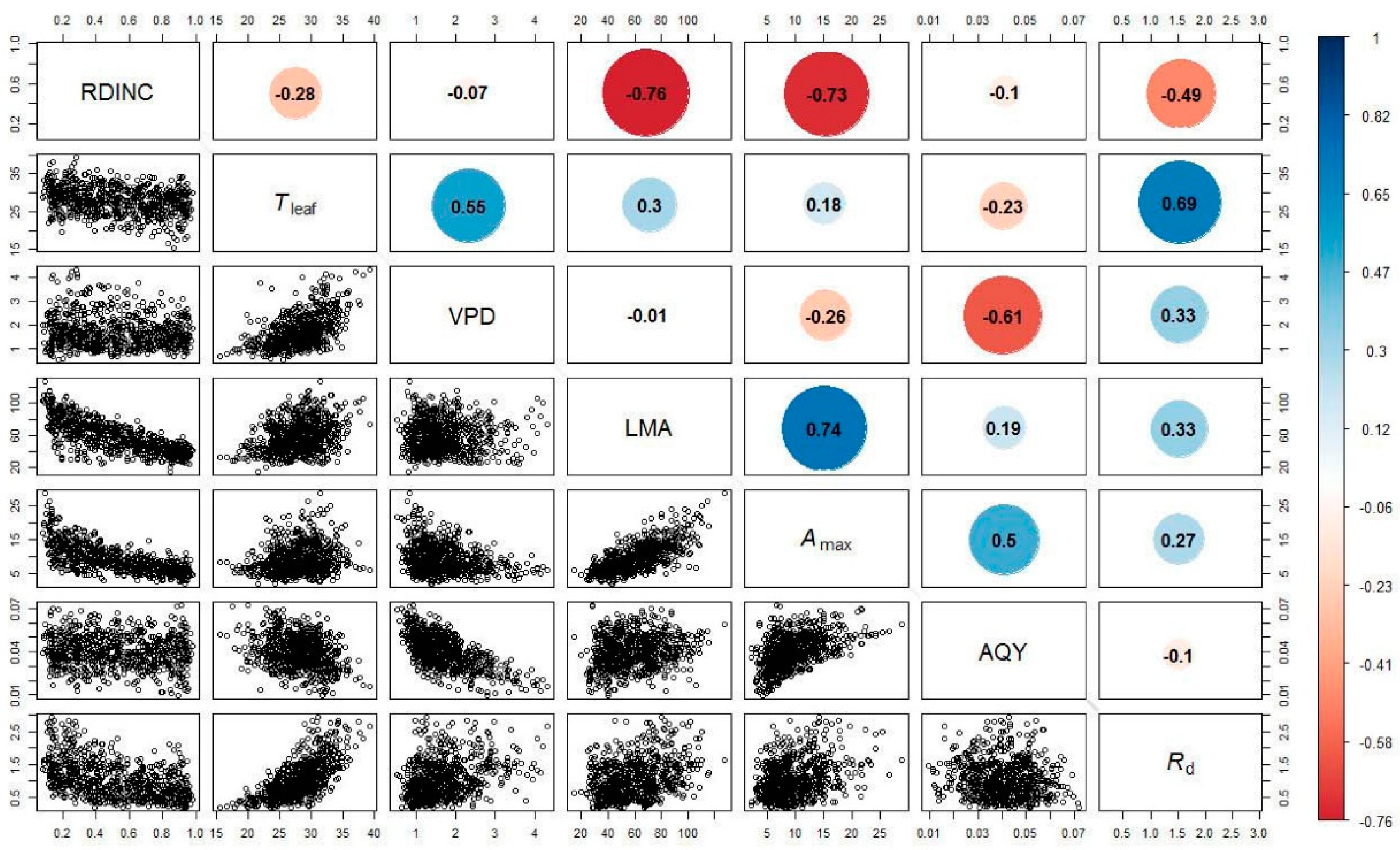
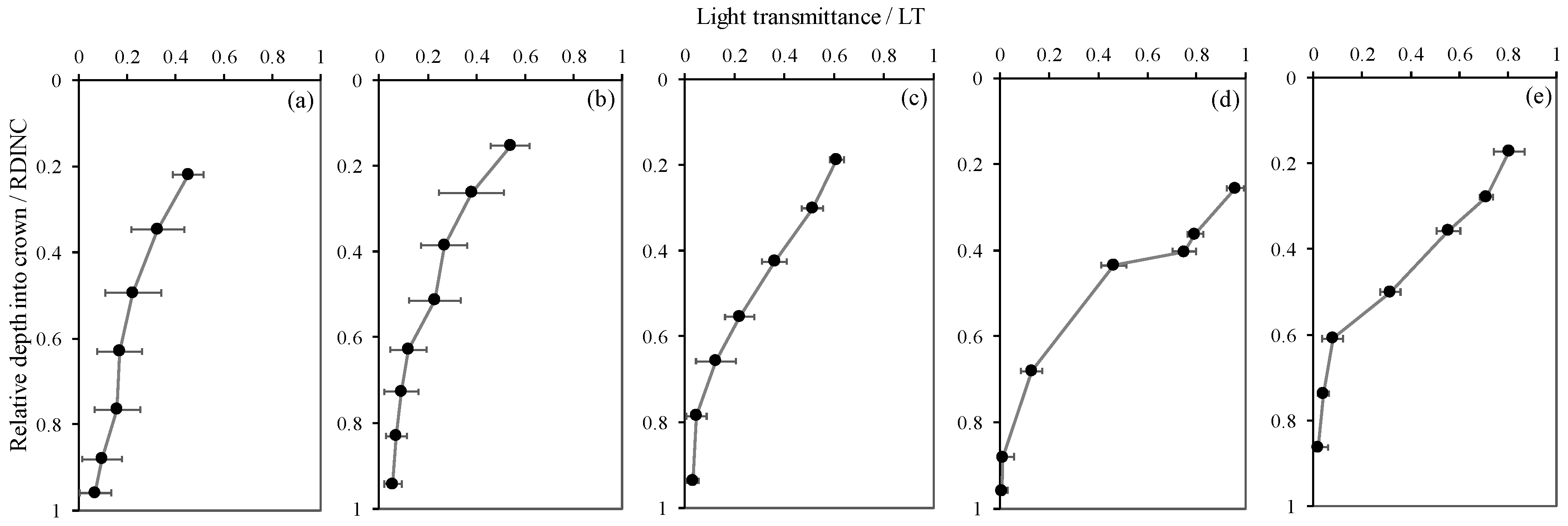
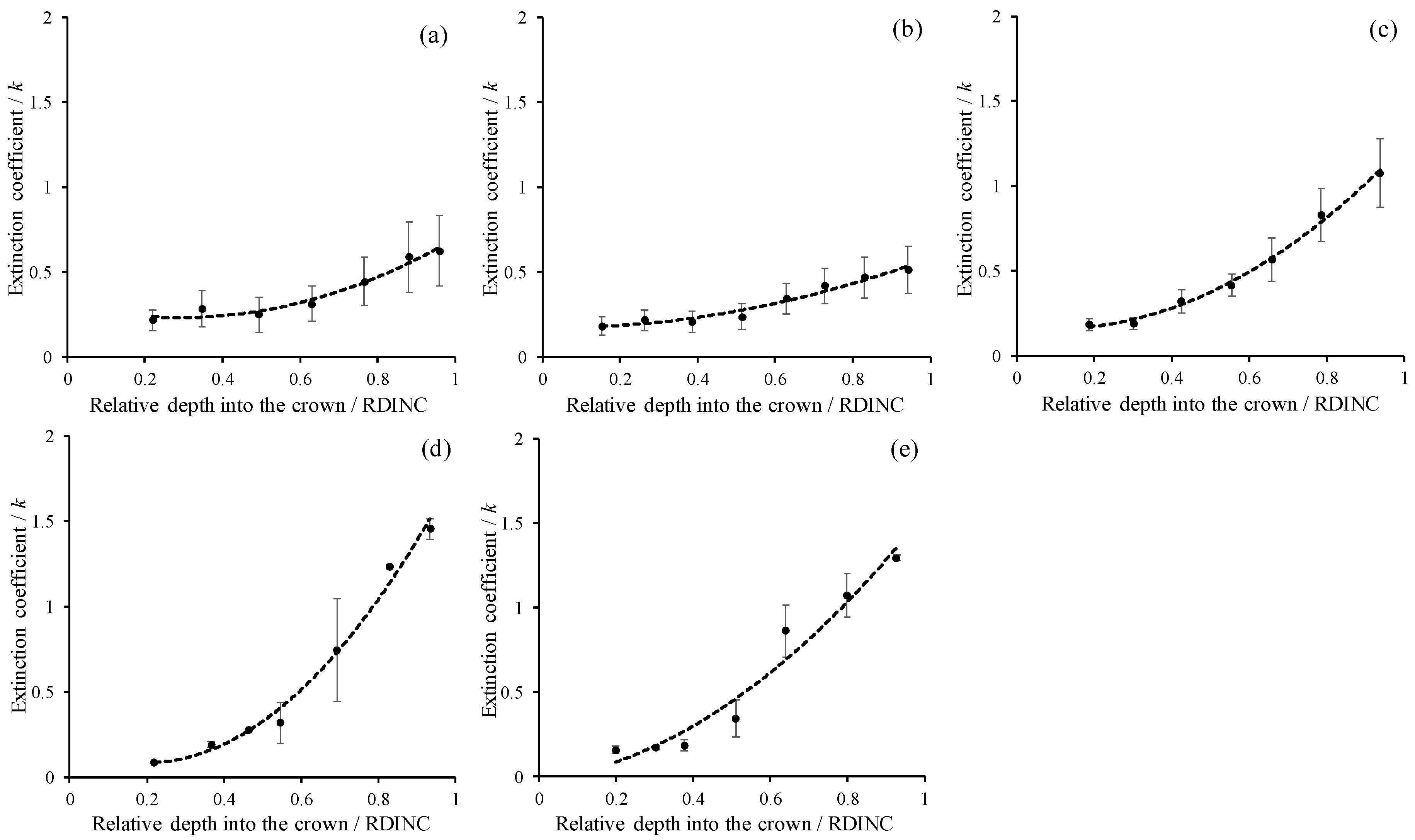
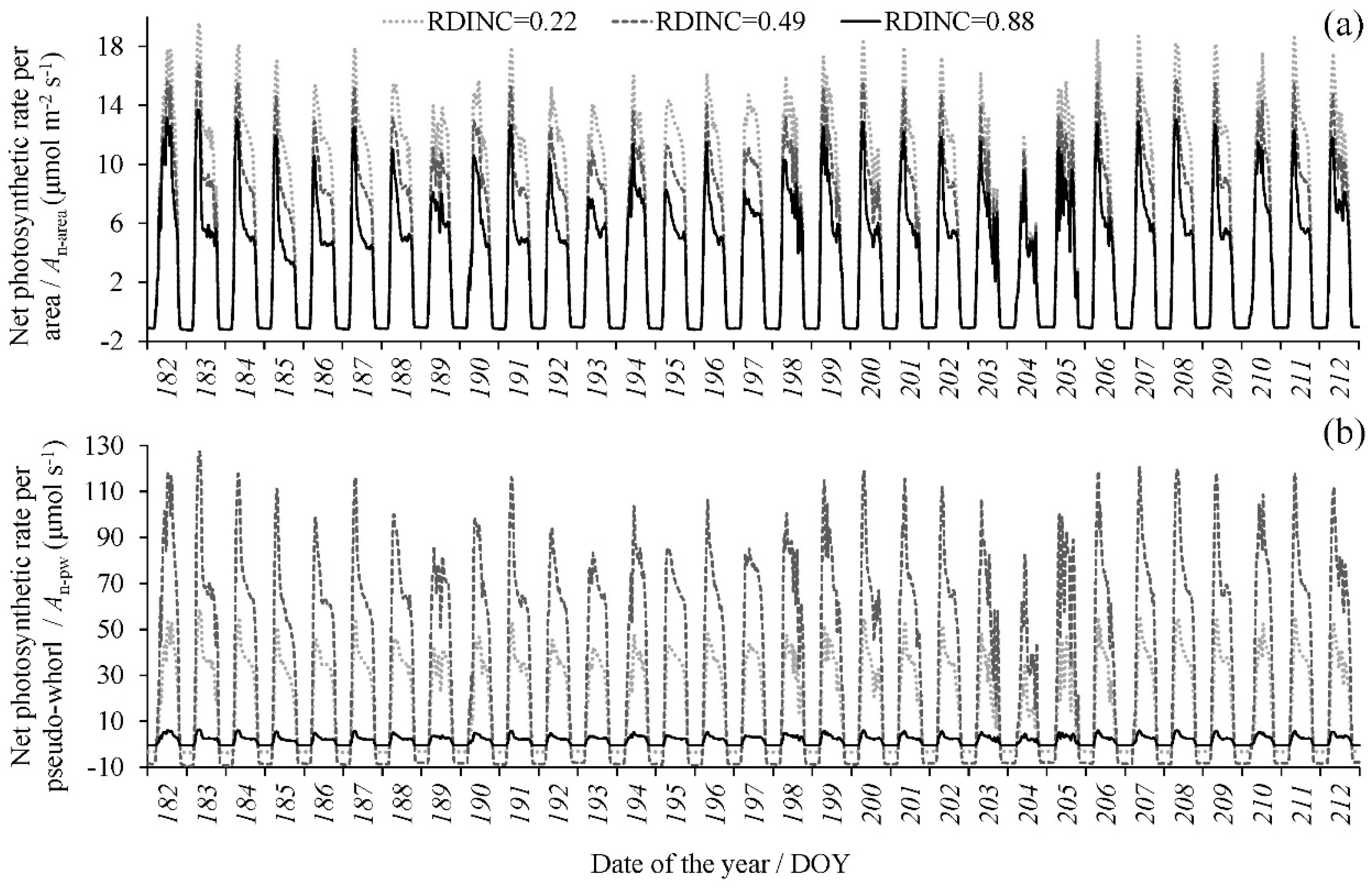
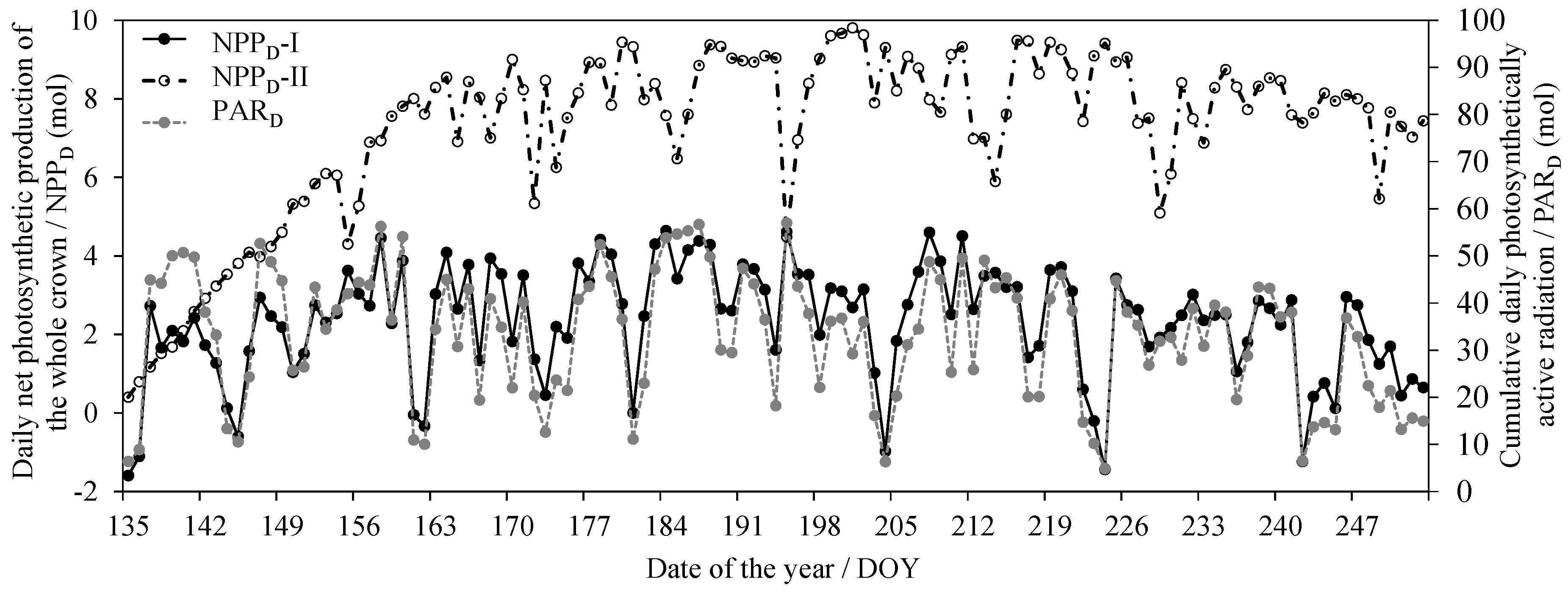


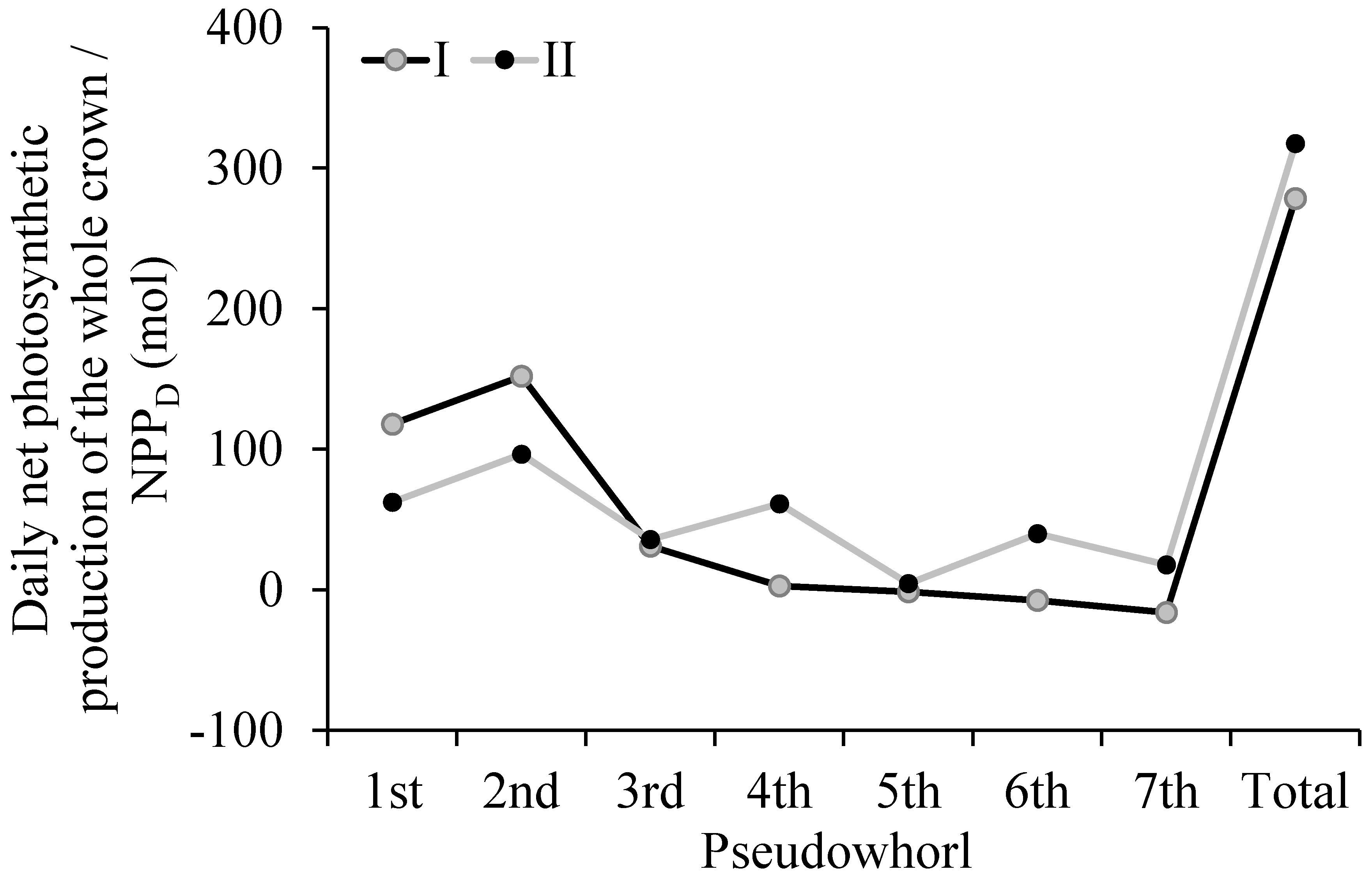
| RDINC | Statistics | Photosynthetic Parameters | Leaf Trait | Environmental Conditions | |||
|---|---|---|---|---|---|---|---|
| Amax (μmol m−2 s−1) | AQY | Rd (μmol m−2 s−1) | LMA (g m−2) | Tleaf (°C) | VPD (kPa) | ||
| 0.1–0.2 | Sample size | n = 1372 (108 PLR curves) | |||||
| Mean | 14.80 | 0.04 | 1.45 | 83.17 | 29.32 | 1.69 | |
| Std. | 4.88 | 0.01 | 0.60 | 18.86 | 3.45 | 0.67 | |
| Max. | 28.77 | 0.07 | 2.93 | 127.53 | 38.15 | 4.05 | |
| Min. | 5.57 | 0.02 | 0.54 | 29.18 | 19.53 | 0.51 | |
| 0.2–0.3 | Sample size | n = 1200 (103 PLR curves) | |||||
| Mean | 11.81 | 0.04 | 1.45 | 72.77 | 29.73 | 1.90 | |
| Std. | 3.43 | 0.01 | 0.60 | 16.76 | 3.45 | 0.83 | |
| Max. | 18.65 | 0.07 | 2.85 | 108.67 | 39.37 | 4.32 | |
| Min. | 5.23 | 0.01 | 0.31 | 29.79 | 23.11 | 0.56 | |
| 0.3–0.4 | Sample size | n = 1077 (89 PLR curves) | |||||
| Mean | 11.08 | 0.04 | 1.11 | 65.21 | 28.03 | 1.68 | |
| Std. | 3.30 | 0.01 | 0.52 | 14.38 | 3.30 | 0.71 | |
| Max. | 17.79 | 0.07 | 2.51 | 92.59 | 35.58 | 3.55 | |
| Min. | 4.70 | 0.02 | 0.18 | 26.64 | 19.74 | 0.78 | |
| 0.4–0.5 | Sample size | n = 958 (75 PLR curves) | |||||
| Mean | 9.92 | 0.04 | 1.01 | 60.00 | 28.31 | 1.72 | |
| Std. | 2.51 | 0.01 | 0.52 | 13.78 | 3.50 | 0.77 | |
| Max. | 15.02 | 0.06 | 2.15 | 84.90 | 36.07 | 3.64 | |
| Min. | 3.21 | 0.01 | 0.31 | 24.85 | 20.42 | 0.65 | |
| 0.5–0.6 | Sample size | n = 959 (78 PLR curves) | |||||
| Mean | 8.72 | 0.04 | 0.91 | 55.58 | 27.40 | 1.70 | |
| Std. | 2.15 | 0.01 | 0.45 | 12.16 | 3.47 | 0.71 | |
| Max. | 13.24 | 0.07 | 2.29 | 84.26 | 34.54 | 3.55 | |
| Min. | 4.41 | 0.02 | 0.19 | 28.85 | 19.71 | 0.67 | |
| 0.6–0.7 | Sample size | n = 896 (73 PLR curves) | |||||
| Mean | 7.38 | 0.04 | 0.83 | 50.24 | 27.12 | 1.62 | |
| Std. | 1.93 | 0.01 | 0.35 | 10.33 | 3.44 | 0.60 | |
| Max. | 13.69 | 0.06 | 1.65 | 77.55 | 34.20 | 3.76 | |
| Min. | 3.07 | 0.01 | 0.30 | 29.31 | 18.96 | 0.79 | |
| 0.7–0.8 | Sample size | n = 1001 (81 PLR curves) | |||||
| Mean | 6.67 | 0.04 | 0.76 | 44.26 | 26.71 | 1.58 | |
| Std. | 1.96 | 0.01 | 0.35 | 8.87 | 3.36 | 0.54 | |
| Max. | 14.87 | 0.06 | 1.91 | 64.23 | 34.20 | 3.33 | |
| Min. | 2.89 | 0.01 | 0.23 | 25.85 | 18.50 | 0.75 | |
| 0.8–0.9 | Sample size | n = 893 (73 PLR curves) | |||||
| Mean | 6.42 | 0.04 | 0.84 | 39.59 | 26.63 | 1.57 | |
| Std. | 1.81 | 0.01 | 0.44 | 7.90 | 3.84 | 0.51 | |
| Max. | 11.93 | 0.07 | 2.13 | 54.49 | 33.46 | 3.01 | |
| Min. | 3.47 | 0.01 | 0.20 | 14.28 | 15.45 | 0.64 | |
| 0.9–1.0 | Sample size | n = 947 (72 PLR curves) | |||||
| Mean | 5.49 | 0.04 | 0.67 | 37.77 | 26.86 | 1.59 | |
| Std. | 1.77 | 0.01 | 0.39 | 7.04 | 3.55 | 0.51 | |
| Max. | 10.99 | 0.07 | 1.84 | 58.73 | 34.38 | 3.07 | |
| Min. | 2.10 | 0.01 | 0.17 | 23.98 | 17.80 | 0.64 | |
| Statistics | Fitting Data | Validation Data | ||||||||
|---|---|---|---|---|---|---|---|---|---|---|
| PARi | PARt | ψ | LAi | RCLAIi | PARi | PARt | ψ | LAi | RCLAIi | |
| Sample size | 386 | 52 | 386 | 36 | 43 | 161 | 23 | 161 | 36 | 43 |
| Mean | 348 | 1439 | 46.9 | 22.41 | 3.49 | 346 | 1480 | 46.4 | 21.46 | 3.39 |
| Std. | 302 | 412 | 14.2 | 12.13 | 0.83 | 352 | 422 | 13.8 | 11.98 | 0.84 |
| Max. | 1356 | 1939 | 68.4 | 37.19 | 4.59 | 1678 | 1931 | 66.9 | 37.19 | 4.59 |
| Min. | 5 | 187 | 13.2 | 0.33 | 0.88 | 4 | 155 | 19.4 | 0.33 | 0.88 |
| Parameters | Estimate | p-Value | Std. Error | Goodness of Fit | Validation | ||||
|---|---|---|---|---|---|---|---|---|---|
| R2 | RMSE (μmol m−2 s−1) | R2 | RMSE (μmol m−2 s−1) | ME (μmol m−2 s−1) | P % | ||||
| a0 | 3.436 | <0.001 | 0.0270 | 0.883 | 1.440 | 0.849 | 1.670 | -0.114 | 93.19 |
| a1 | −5.448 | <0.001 | 0.1283 | ||||||
| b0 | −0.014 | <0.001 | 0.0002 | ||||||
| b1 | 0.062 | <0.001 | 0.0009 | ||||||
| Rd | 0.979 | <0.001 | 0.1931 | ||||||
| Parameters | Estimate | p-Value | Std. Error | Goodness of Fit | Validation | ||||
|---|---|---|---|---|---|---|---|---|---|
| R2 | RMSE | R2 | RMSE | ME | P% | ||||
| d0 | 0.006 | <0.001 | 0.001 | 0.525 | 0.159 | 0.619 | 0.170 | 0.038 | 93.15 |
| d1 | −0.028 | <0.001 | 0.004 | ||||||
| d2 | 1.275 | <0.001 | 0.138 | ||||||
| e0 | −0.037 | 0.0237 | 0.014 | ||||||
| e1 | 2.133 | <0.0001 | 0.449 | ||||||
© 2019 by the authors. Licensee MDPI, Basel, Switzerland. This article is an open access article distributed under the terms and conditions of the Creative Commons Attribution (CC BY) license (http://creativecommons.org/licenses/by/4.0/).
Share and Cite
Liu, Q.; Xie, L.; Li, F. Dynamic Simulation of the Crown Net Photosynthetic Rate for Young Larix olgensis Henry Trees. Forests 2019, 10, 321. https://doi.org/10.3390/f10040321
Liu Q, Xie L, Li F. Dynamic Simulation of the Crown Net Photosynthetic Rate for Young Larix olgensis Henry Trees. Forests. 2019; 10(4):321. https://doi.org/10.3390/f10040321
Chicago/Turabian StyleLiu, Qiang, Longfei Xie, and Fengri Li. 2019. "Dynamic Simulation of the Crown Net Photosynthetic Rate for Young Larix olgensis Henry Trees" Forests 10, no. 4: 321. https://doi.org/10.3390/f10040321
APA StyleLiu, Q., Xie, L., & Li, F. (2019). Dynamic Simulation of the Crown Net Photosynthetic Rate for Young Larix olgensis Henry Trees. Forests, 10(4), 321. https://doi.org/10.3390/f10040321





